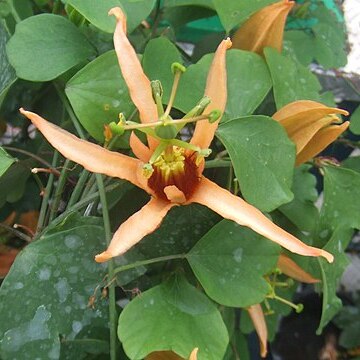Perennial vine to c. 5 m long, with simple axillary tendrils, pubescent (var. pubescens) or glabrous. Stem subterete, slender. Stipules linear, 0.25–3 mm long, 0.25–1 mm wide. Leaves alternate, 3-lobed to c. ½ of length; lobes widest at base, ovate, obtuse or rounded, each with a single main vein; lamina (1.5–) 3–7 (–14) cm long, (2–) 3–8 (–12) cm wide, with glands scattered abaxially or in a line on either side of midvein (not in Australia), base rounded or truncate, occasionally cuneate, margin entire; petiole (0.5–) 1.5–3.5 (–9) cm long, without or with 2 glands, 0.5–3 mm long, near lamina. Flowers bisexual, borne singly or in pairs in leaf axils, 5–8 cm diam.; pedicels 1–7 cm long; bracts 1–3, filiform, 2–4 mm long, 0.25–0.5 mm wide. Sepals yellow or cream turning salmon pink as flower ages, 2–5 cm long, keeled. Petals yellow or cream turning salmon pink as flower ages, 1.5–2.5 cm long. Corona a single series of filaments, red, (3–) 12–20 mm long. Operculum yellow-green, membranous, plicate, upper margin fimbriate, 1–2 cm long. Androgynophore straight, 1.5–4.5 cm long. Stamens 5. Styles (2) 3 (4). Fruit an ovoid berry, 1.5–5 cm long, 1.5–5 cm wide, green when mature. Seeds reticulate.
More
A climber which climbs by tendrils. It is slender with wiry stems. The leaves are small. They are 2-10 cm long by 2-8 cm wide. They are deep green. The leaves have 3 lobes. The flowers are 11 cm across. The flowers are white when they open but turn red. The fruit are 3-5 cm long by 2-4.5 cm wide. The are almost round and pale green. They become purplish when ripe.
A tropical plant. It grows in coastal scrub and on the edge of rainforests. It grows in acidic soils and sands. It can grow in tropical, subtropical and warm temperate regions. It needs well drained soils. It does best with light shade. They can stand some frost.
More
Often in coastal and near-coastal scrub, Eucalyptus woodlands, rainforest margins or clearings or at disturbed sites, climbing over regrowth.

